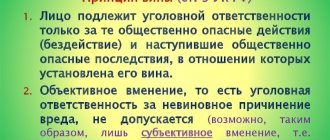Destruction of critical habitats for organisms listed in the Red Book of the Russian Federation, resulting in the death of populations of these organisms, is punishable by a fine in the amount of three hundred thousand to five hundred thousand rubles or in the amount of the wages or other income of the convicted person for a period of two to three years, or by mandatory labor for a term of up to four hundred eighty hours, or restriction of liberty for a term of up to three years, or forced labor for a term of up to three years, or imprisonment for the same term.
Problems of criminal liability for incitement to suicide
The work examines problematic issues of criminal liability for incitement to suicide under Kazakh criminal legislation. The authors believe that these crimes are latent in nature, since proving the fact that there was incitement to suicide, and not voluntary death, is a big problem in solving this crime. Therefore, it is necessary to improve the techniques and methods of identifying and solving this crime. According to the authors, prevention of incitement to suicide lies not only in imposing punishment, but also in carrying out social, cultural and ideological events that should be carried out at the state level.
In accordance with Art. 12 in the Republic of Kazakhstan human rights and freedoms are recognized and guaranteed. Human rights and freedoms belong to everyone from birth, are recognized as absolute and inalienable, and determine the content and application of laws and other normative legal acts. The human right to life is one of the determinants of the legal status of a citizen in the state (Article 15 of the Constitution of the Republic of Kazakhstan). The Universal Declaration of Human Rights (1948) also declares that the value of the human person is “everyone’s right to life.”
Such significance of the “human right to life” and the fact that life is the highest social value protected by law puts the task of protecting it in one of the first places before the authorities and management.
Human life is the most valuable gift of nature. Suicide occupies a special place among the causes of premature death. Suicide, like crime, is characteristic of any human society at any stage of its existence. In recent years, the problem of suicide has become relevant in all countries of the world due to a sharp increase in the number of suicides. According to the UN, 130 thousand suicides occur annually in developed countries of the world; people often commit suicide between the ages of 15 and 44 years. According to this organization, if about a million people commit suicide a year, then eight thousand of them are Kazakhstanis [1].
Suicide, suicide (from Latin sui caedere - to kill oneself) is the deliberate taking of one’s life [2], usually independent and voluntary [3].
According to E.G. Ermolaeva “suicide (suicide) is one of the forms of deviant behavior. Deviant behavior is the commission of actions that contradict the norms of social behavior in a particular community. The main types of deviant behavior include: crime, alcoholism, drug addiction, suicide and prostitution. Human behavior, which is a conscious, deliberate taking of one’s own life, committed by the victim himself under the influence of any traumatic situations or other circumstances leading the individual to the decision of self-destruction” [4].
Among the determinants of suicides committed as a result of intimidation, the following are included (%): “medical” (71.4), “psychological” (47.6), “economic” (42.9), “social” (28.6), “personal” (19.0), “everyday” (16.7), “criminological” (7.1), “genetic” (4.8) [5].
Now the problem of child suicide is especially acute. The leading reason that provokes teenagers to attempt suicide is the dominance of feelings of hopelessness and helplessness. Child mortality is always inexplicable and very tragic, not only for the children’s relatives, but also for society as a whole. Therefore, such children need special attention, protection and assistance from their families [6].
Suicide, as such, is not a problem of criminal law. But incitement to suicide is a socially dangerous act, where one of the basic human rights is violated - the right to life [7, p.217]. Incitement to suicide in the Republic of Kazakhstan is subject to criminal liability under Art. 105 of the Criminal Code of the Republic of Kazakhstan.
Methods of incitement to suicide are stipulated by the legislator in the law. These include: 1) threats; 2) cruel treatment; 3) systematic humiliation of human dignity. If it is established that the victim was financially or otherwise dependent on the perpetrator, the act is qualified under Part 2 of Art. 105 of the Criminal Code of the Republic of Kazakhstan [8].
Thus, A. A. Tsyrkalyuk emphasizes that in a number of foreign countries, with a more detailed analysis, it is possible to identify various elements of crimes similar to the elements of incitement to suicide, namely: incitement to suicide (Austria, India, Italy); assisted suicide (Denmark, USA, Tunisia, Philippines, Chile); inclination to suicide (Armenia, Belarus, Kyrgyzstan, Turkmenistan); approval of suicide (Australia); incitement to suicide (Azerbaijan, Armenia, Belarus, Moldova) [9].
We believe that the most dangerous way to induce suicide is to provide information from the global network - the Internet, where there are sites that distribute methods of committing suicide. This information becomes available to a wide range of people, especially minors. In this regard, we note that the development of the bill “On the protection of children from information harmful to their health and development” is becoming particularly relevant and justified. Such a bill should regulate the protection of children from information harmful to health and/or development.
A mandatory element of a crime under Art. 105 of the Criminal Code of the Republic of Kazakhstan there is a causal connection between the fact of suicide (attempt) and the act of the perpetrator, i.e. it must be established that it was the unlawful actions (inaction) of the person that served as the immediate cause that pushed the victim to commit suicide. If the victim committed suicide for other reasons, then criminal liability under Article 105 of the Criminal Code of the Republic of Kazakhstan is excluded. Thus, the legal imprisonment of the person who committed the crime, or refusal to marry, resulting in the suicide of the victim, does not form the crime in question [8].
It is considered completed in cases where the actions of the perpetrator resulted in murder or an attempt on his life.
The subjective side of incitement to suicide is characterized by indirect intent. If this crime is committed with direct intent, the action of the perpetrator should be qualified as premeditated murder under the relevant part of Art. 99 of the Criminal Code of the Republic of Kazakhstan [7, p. 220].
Any person can be recognized as a victim According to Part 2 of Art. 105 of the Criminal Code of the Republic of Kazakhstan is a person who was financially or otherwise dependent on the perpetrator. According to Part 3 of Art. 105 of the Criminal Code of the Republic of Kazakhstan - a minor.
Subject is a sane individual who has reached the age of 16 [8].
If incitement to suicide is committed by an official, his actions are qualified as a set of crimes provided for in Art. 105 and part 4 of Art. 362 of the Criminal Code (Excess of power or official authority, resulting in grave consequences) [8].
Official statistics (and which most experts believe to be underestimated) of criminal cases under Art. 105 of the Criminal Code of the Republic of Kazakhstan, there are very few cases brought to a court decision, in 2021 - 7 people. High degree of latentization (on average, in every two out of five registered crimes, the person involved in their commission is not identified). In certain social groups, cases of suicide are almost always the result of intimidation. These groups include military personnel, as well as convicts serving sentences in prisons [5]. In fact, this norm is “sleeping”. As noted by N.A. Safonova: “Many mistakes are made when qualifying the actions of the perpetrator. This circumstance is largely due to the imperfection of the current criminal legislation, insufficient knowledge of the crime being analyzed, in addition, the lack of experience among investigators and judges in proving the fact of incitement to suicide has a significant impact on the investigation of the crime.”[10]. Such a complex psychological structure of these acts leads to the fact that law enforcement officers experience significant difficulties during investigation and proof. It is quite difficult, and sometimes impossible, to identify these acts without a statement from the victim (in the case of an attempted suicide) or his relatives, if there is no one to report the facts of systematic humiliation and cruel treatment. As a result, criminal cases of incitement to suicide are either terminated at the stage of preliminary investigation due to the lack of corpus delicti or, for the same reasons, “fall apart” in court.
At the state level, prevention measures related to suicide are insufficient, although psychological trust services are provided and a full-time psychologist is maintained in all government spheres. Therefore, it is important to comprehensively understand the processes occurring in the minds of young people, predict trends and search for solutions to problems [11].
Therefore we offer:
- Expand the list of ways to commit a crime by adding to the disposition of Art. 105 of the Criminal Code of the Republic of Kazakhstan by means of threats, bribery, deception, as well as assistance in committing suicide through information, provision of means or instruments for committing a crime.
- In connection with the need to take into account the difference in the degree of public danger of driving a victim to suicide, for a clearer differentiation of criminal liability depending on the subject of the attack, it seems advisable to supplement Art. 105 of the Criminal Code of the Republic of Kazakhstan, part 2, which provides for liability for an act committed against close relatives, a person known to be in a helpless state for the perpetrator and stated as follows:
Article 105 of the Criminal Code of the Republic of Kazakhstan Incitement to suicide
- The same act committed against close relatives, a person known to be in a helpless state by the perpetrator, a person who was financially or otherwise dependent on the perpetrator,
- shall be punishable by restriction of freedom for a term of up to five years, or imprisonment for the same term.
- Due to insufficient training of lawyers on suicide prevention, introduce a special course at law faculties: “A system of measures to prevent crimes related to incitement to suicide.” This discipline should be aimed at studying suicides resulting from intimidation and measures to prevent them.
- Develop comprehensive measures at the state level to prevent suicide in society and in certain groups of the population - military personnel, convicts, law enforcement officers, minors, etc.
- Maintain strict records of all suicidal behavior and self-harm incidents.
List of used literature
- Incitement to suicide: criminal legal aspect // https://www.prorektor.ru.
- Bleher V.M., Kruk I.V. Explanatory Dictionary of Psychiatric Terms / Ed. Ph.D. S.N. Bokova. In 2 volumes. T. 2 – Rostov-on-Don: “Phoenix”, 1996. – 448 p.
- Antsupov A.Ya., Shopilov A.I. Dictionary of conflictology. – 2nd ed. – St. Petersburg: Peter, – 381-526 p.
- Ermolaeva E.G. Suicide and crime: Author's abstract. dis. ...cand. legal Sci. – Saratov, 2007. . – 21 s.
- Volkonskaya E.A. Prevention of incitement to suicide: criminal legal and criminological aspects: Author's abstract. dis. ...cand. legal Sci. – Ryazan, 2011. – 24 p.
- Sabitova Sh.A. International legal protection of children's rights // Bulletin of KazNPU named after. Abay, Series “International Life and Politics” No. 3 (46), 2021. – P.60.
- Borchashvili I.Sh., Zhumaniyazov M.A. Crimes against life: Monograph. – Astana: Institute of Legislation, 2009. – 428 p.
- Commentary on the Criminal Code of the Republic of Kazakhstan / ed. I. Sh. Borchashvili. Almaty: Zhetizhargy, 2007. – 992 p.
- Tsyrkalyuk, A.A. Responsibility for incitement to suicide under foreign criminal law // International public and private law. No. 2. – pp. 47-48.
- Safonova N.A. Controversial issues of the concept of “suicide” // Russian Legal Journal. – No. 4. – P. 42.
- Seralieva A.M., Baimagambetova Z.M. Psychological aspects of the formation of legal consciousness among students // Bulletin of KazNPU named after. Abay, Series “Psychology” No. 4 (49), 2021. – P.
Commentary on Article 259 of the Criminal Code of the Russian Federation
1. The direct object of the crime is relations to protect rare and endangered species of animals and plants.
The protection of such species of animals and plants is regulated by general and special regulatory legal acts. General regulatory legal acts include, in particular, the Federal Law of March 14, 1995 N 33-FZ “On Specially Protected Natural Territories” (as amended on June 25, 2012) <1>, the Law on Wildlife, the Law on the Continental Shelf, Law on Environmental Protection, VK, LC. Special regulatory legal acts include, for example, Resolution of the Government of the Russian Federation dated February 19, 1996 N 156 “On the procedure for issuing permits (administrative licenses) for the circulation of wild animals belonging to species listed in the Red Book of the Russian Federation” (as amended on April 22 .2009) <2>; dated 02/19/1996 N 158 “On the Red Book of the Russian Federation” <3>; dated 01/06/1997 N 13 “On approval of the Rules for obtaining objects of the animal world belonging to species listed in the Red Book of the Russian Federation, with the exception of aquatic biological resources” (as amended on 04/22/2009) <4>.
——————————— <1> NW RF. 1995. N 12. Art. 1024; 2002. N 1 (part 1). Art. 2; 2005. N 1 (part 1). Art. 25; N 19. Art. 1752; 2006. N 50. Art. 5279; 2007. N 13. Art. 1464; N 21. Art. 2455; 2008. N 29 (part 1). Art. 3418; N 30 (part 2). Art. 3616; N 49. Art. 5742, 5748; 2009. N 1. Art. 17; N 52 (part 1). Art. 6455; RG. 2011. N 159, 160; NW RF. 2011. Art. 6732; N 49 (part 1). Art. 7043; 2012. N 26. Art. 3446. <2> NW RF. 1996. N 9. Art. 807; 2003. N 17. Art. 1621; 2004. N 51. Art. 5188; 2009. N 18 (part 2). Art. 2248. <3> NW RF. 1996. N 9. Art. 808. <4> NW RF. 1997. N 3. Art. 385; 2003. N 17. Art. 1621; 2004. N 51. Art. 5188; 2008. N 18. Art. 2052; 2009. N 2. Art. 223; N 18 (part 2). Art. 2248.
The Red Book of the Russian Federation is a kind of cadastre of rare and endangered species of plants and animals. The procedure for maintaining the Red Book of the Russian Federation is determined by the Decree of the Government of the Russian Federation “On the Red Book of the Russian Federation”.
2. The subject of the crime is organisms listed in the Red Book of the Russian Federation, i.e. corresponding animals and plants.
Inclusion of a biological organism in the Red Book of the Russian Federation means: widespread removal of animals and plants from economic circulation and a complete ban on any use (collecting, storing berries, plants, shooting, catching animals, changing living conditions, etc.), with the exception of use for the purposes of reproduction and conservation of species, carried out on the basis of special permits.
In the Red Book of the Russian Federation, in accordance with the Red Book of the International Union for Conservation of Nature and Natural Resources, five categories of plants and animals are distinguished:
1) endangered, the salvation of which is impossible without the implementation of special measures;
2) whose numbers are relatively high, but are declining catastrophically quickly, which in the near future may put them at risk of extinction;
3) rare organisms that are not in danger of extinction, but due to unfavorable changes in their habitat, due to their small numbers, they may become endangered;
4) whose biology has not been sufficiently studied, but their condition is alarming;
5) restored species, the condition of which, thanks to the protection measures taken, does not cause concern, but they require constant monitoring.
3. From the objective side, the crime is expressed in the destruction of critical habitats for organisms listed in the Red Book of the Russian Federation. Destruction is the rendering of critical habitats completely unsuitable for the existence of these organisms, excluding the implementation of their life cycles.
Methods for destroying critical habitats are varied and have no significance for qualification: poisoning, contamination of the territory, burning or deforestation, flooding of habitats, creating a disturbance factor through economic activity, etc. If the destruction of the habitats of animals and plants specified in the commented article has occurred if there are signs of the crimes specified in Art. Art. 246, 250, 254, 257, 261 or 262 of the Criminal Code, the deed forms a set of these crimes and is qualified under Art. 259 and the corresponding article of the Criminal Code, since they do not cover the destruction of habitats of populations of “Red Book” animals and plants.
Consequences in the form of death of populations of organisms listed in the Red Book of the Russian Federation are a mandatory sign of a crime.
A population is a collection of individuals of the same species that occupies a certain space for a long time and reproduces itself over a large number of generations. The population can occupy a significant space (distribution area), up to the entire territory of the Russian Federation and beyond.
When applying this article, in our opinion, the concept of “population habitat” should be interpreted in a limited way and only the territory within certain boundaries (reservoir, forest, tract, wetland, etc.) should be considered as such. Otherwise, the commented article is practically inapplicable.
The law refers to populations in the plural, but the death of at least one population should entail criminal liability. In this case, we are dealing with the linguistic features of the legislative construction of the norm, just as in Art. Art. 256, 258, 260 of the Criminal Code, etc.
A causal relationship must be established between consequences and actions.
The location of the crime is the critical habitats of the specified organisms, i.e. specially designated protective areas of the natural environment (steppe, forest, water areas, etc.), in which organisms listed in the Red Book of the Russian Federation live (grow) in a state of natural freedom. These areas are of a protective nature; all types of economic activity are prohibited in them, or certain types of economic activity are prohibited at all times of the year or activities in certain seasons of the year, or the timing and methods of its implementation are regulated.
Habitats are called critical because they are habitats for populations of rare or endangered species of organisms listed in the Red Book of the Russian Federation.
The corpus delicti is material. The crime is considered completed from the moment the consequences occur.
4. The subject of the crime is a sane individual who has reached the age of 16.
5. The subjective side of the crime involves an intentional or careless form of guilt.
With direct intent, a person, when destroying a critical habitat, is aware of the social danger of his actions, foresees the possibility or inevitability of the death of populations, organisms listed in the Red Book of the Russian Federation, and desires the occurrence of these consequences. With indirect intent, a person is aware of the social danger of his actions, foresees the possibility of the death of populations of “Red Book” organisms, does not want, but consciously allows these consequences or is indifferent to them.
In case of negligence, a person does not foresee the possibility of the occurrence of the consequences of his actions specified in the law, although with the necessary care and forethought he should and could have foreseen these consequences. In case of frivolity, a person foresees the possibility of consequences, but without sufficient grounds for this, he arrogantly hopes to prevent the consequences.
6. The crime in question should be distinguished from a number of administrative offenses provided for in Art. Art. 8.29, 8.33, 8.35, part 3 art. 8.37 Code of Administrative Offences.
Provided by Art. 8.29 of the Administrative Code, an offense, unlike a crime, is committed in places not classified as critical habitats, and in relation to any animals (insects, birds, animals, etc.), and not just those listed in the Red Book of the Russian Federation, and does not entail those specified in Art. . 259 of the Criminal Code of consequences.
Article 8.33 of the Code of Administrative Offenses is applied if the habitat or migration routes of animals are not covered by the concept of “critical habitat for organisms listed in the Red Book of the Russian Federation” and does not entail their destruction.
According to Art. 8.35 of the Code of Administrative Offenses punishable are acts of destruction of individual “Red Book” animals and plants that do not form a population, as well as other actions (inaction) that only create a threat of their death.
The difference between a crime and a misdemeanor under Part 3 of Art. 8. 37 of the Code of Administrative Offences, consists in the absence of consequences as a necessary feature of the latter.






